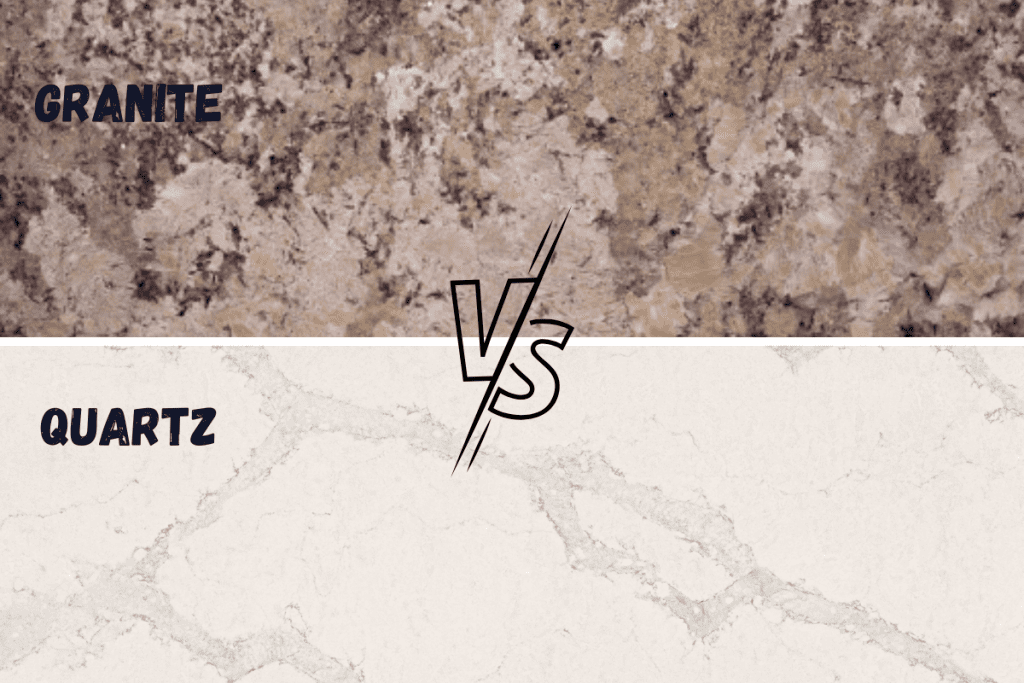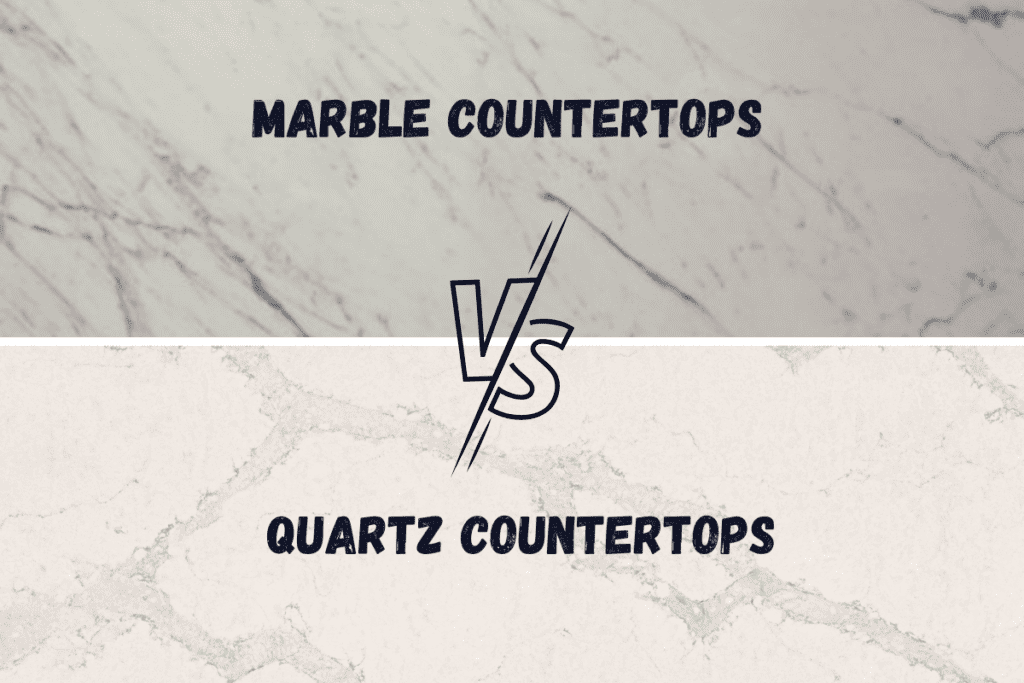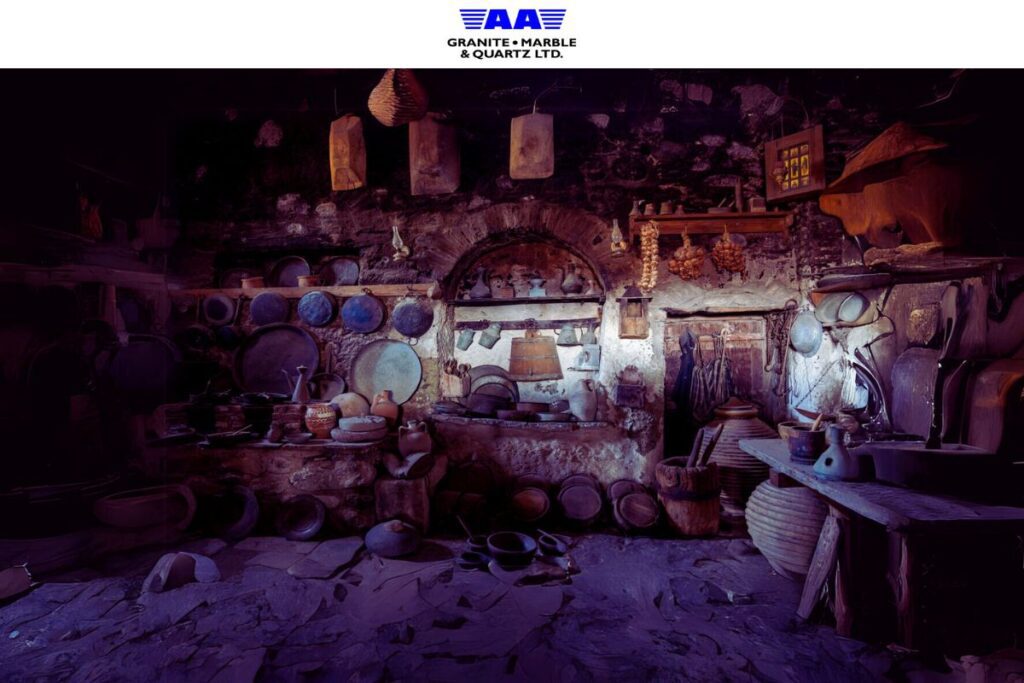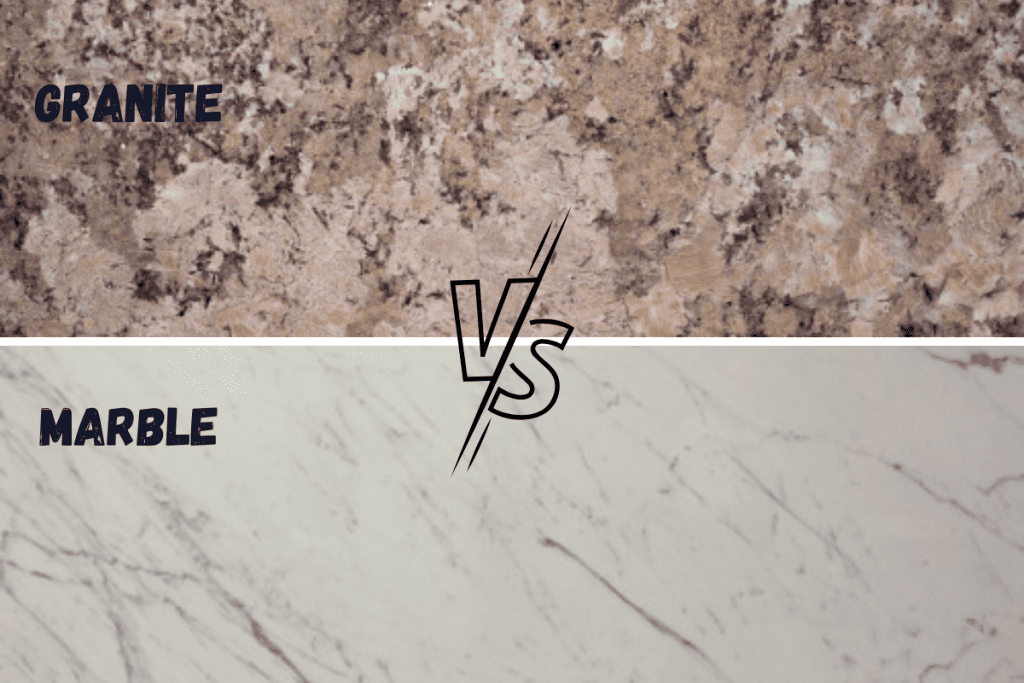Choosing the right material is very important if you plan to outfit your kitchen or bathroom countertops with a new surface. You want to ensure that your new countertops are heat, scratch, and stain resistant and affordable!
Quartz and granite are among the most popular options for home countertops, known for their beauty and affordability. In the never ending debate about quartz vs. granite countertops, we’ll dig deep into the benefits and drawbacks of both materials to help you make an informed choice!
Benefits and Drawbacks of Quartz Countertops
Benefits
For those who want to branch away from the porcelain or decorative laminate coverings that many old houses have, quartz is a great alternative.
Quartz is an engineered stone composed primarily of natural quartz crystals, resins, and pigments. Therefore, countertops are great for any kitchen because they can withstand high temperatures. If you need to set a hot pan down on your countertop, quartz can handle the heat just fine. It is also resistant to stains and scratches, which is great for a busy family who uses the kitchen often. That’s what makes this durable material such a fan favorite among families!
If you decide to outfit your bathroom countertops with quartz, you’ll be happy to know that its non-porous surface prevents bacterial growth. Proper sealing techniques from your manufacturer will help you combat mold and mildew accumulation in a wet environment like your bathroom. Just ensure you keep up resealing your countertops per any manufacturer’s instructions.
One of the greatest advantages of choosing quartz over any other material is that it is easy to clean and maintain. There are plenty of sealing and cleaning kits out there that you can find either online or in-store. So, it shouldn’t cost much to keep your countertops clean and maintained.
Finally, quartz comes in a wide range of colours and patterns, making it easy to match with whatever colour palette you are designing your home. For example, white, grey, and black quartz countertops are very popular and easy to pair with bold or soft-coloured cabinets or walls. If you want to get adventurous, quartz comes in desert browns, pinks, and even gold and green – depending on where you go.
Drawbacks
Unfortunately, even with all of those benefits, there are still some drawbacks to choosing quartz for your countertop.
For instance, did you know your lovely quartz countertop colours can fade when exposed to too much sunlight? While this can be relatively rare under normal conditions, those who want to put countertops outside in a grill space may find their quartz drained of its beautiful colour over time.
Not only that, but quartz can still be pretty pricey. Even though it is still cheaper than granite or marble, quartz is more expensive than the affordable, cheaper options, such as laminate, concrete, or tile. While it is possible to find quartz materials either on sale, at better-priced quarries, or from cheaper manufacturers, many homeowners will find that outfitting their home with quartz may come with a hefty price.
Benefits and Drawbacks of Granite Countertops
Benefits
Granite is a highly coveted choice for household countertops. Granite stone has natural veining patterns that have taken shape over millions of years due to the cooling of lava. Comprising numerous minerals, these elements contribute to the remarkable patterns and colours exhibited by the stone. Imagine the allure of having a piece of cooled lava rock right in the comfort of your own home!
Granite also offers remarkable durability, capable of withstanding heavy usage, scratching, chipping, and exposure to heat. Thus, it is considered another popular material for kitchen counters – especially for chefs! That’s because the polished finishes and surfaces of granite countertops provide an added safeguard, shielding the natural stone from staining or damage.
With an extensive assortment of colours, patterns, and veining to choose from, granite can seamlessly integrate into any kitchen plan, regardless of the specific colour palette you envision. From classic hues like red, brown, black, and white to more unique shades such as yellow, green, and blue, granite truly offers a diverse and captivating range of options for your home design aspirations.
Drawbacks
Quartz, mica, and feldspar are among the minerals that contribute to granite’s distinctive patterns and colours. However, small gaps between these minerals result in a coarse and rough texture, necessitating thorough sealing before it can serve as a suitable countertop surface. Achieving a complete and uniform sealing demands both time and skill, contributing to the higher cost of granite.
Granite is also susceptible to chipping or cracking if you drop something heavy on it, so be sure to take good care of your countertops and maintain them when necessary.
Speaking of maintenance, granite countertops necessitate regular cleaning and resealing to preserve their pristine condition and protect them from stains and damage. Although the stone is resistant to staining and is initially sealed upon installation, it’s still advised to reapply the sealing every few years to maintain its durability and appearance.
Differences in Appearance Between Quartz and Granite
Unlike granite, which is a natural stone, quartz is a man-made product designed to mimic the appearance of natural stones like marble and granite. As a result of its engineered nature, quartz countertops offer a wide range of colours and patterns, providing more design options for homeowners. It also makes it much cheaper, but the design or look of it may not be as pretty as granite or marble.
In contrast, The minerals within granite, such as quartz, mica, and feldspar, contribute to its captivating patterns and colours, giving each slab a one-of-a-kind appearance. From dramatic veining to specks and swirls, granite offers a rich and diverse visual appeal that cannot be replicated precisely from one slab to another. On the other hand, the patterns and colours in quartz are more predictable than the variations found in natural stones like granite.
Therefore, homeowners seeking a more consistent, repeated aesthetic throughout their kitchens or bathrooms may find quartz to be the more suitable choice.
Depending on your needs or personal tastes, you may prefer the wild nature of granite or the uniform beauty of quartz. It all depends on your design goals and whether or not each stone will help you meet them.
Popular Trends for Quartz and Granite Countertops
If you decide to go with one material or the other, it is best to know which designs are currently trending to prevent your house from looking outdated before you even begin.
Probably the most popular for quartz and granite is white, cream, or grey colouring with a slight marbling or simple vein design. Most modern kitchens and bathrooms adopt a black-and-white design with only a few shocks of colour, such as blue cabinets or gold accents. However, black and blue-grey countertops are also popular right now, and most quartz and granite stones are available in those colours.
In particular, quartz countertops are engineered and designed to come in almost every possible colour or pattern that you might want. That makes them much higher in demand for interior designers or homeowners with a specific colour palette vision in mind. While there are limitations, as the stone is built from natural materials, the possibilities there are much more varied than with granite or marble. Plus, quartz tends to be cheaper due to its engineering. Conversely, granite comes in limited colours, but the most popular are still white, grey, and cream tones.
Durability and Resistance to Damage of Quartz and Granite Countertops
Both quartz and granite countertops are relatively durable and can withstand everyday impacts.
However, as a natural stone, granite tends to be more susceptible to chipping or cracking upon heavy impact, especially along the edges. On the other hand, quartz, as an engineered stone, is generally more resilient to impacts due to its composition of natural quartz crystals and resins, which provide a certain level of flexibility.
According to a case study created by Consumer Reports, quartz holds up better to stains and heavy impact. It is also easier to trim to size to create a uniform and aesthetically pleasing surface in your home. Granite must be sealed annually to prevent staining and scratching and is more susceptible to harsh all-purpose cleaners.
Remember that both materials are durable stones, and while granite may need more maintenance than quartz, it still would serve you well and shine bright in your home.
Maintenance and Care For Quartz and Granite Surfaces
Cleaning Instructions for Quartz Countertops
Cleaning agents such as Clorox wipes, bleach, or oven cleaners should never be used on your quartz countertop, as those chemicals can begin to wear away at the stone’s surface. Also, you should avoid wiping down your countertops with rough materials, such as steel wool. While that might work on some stovetops or on particularly difficult oven stains, it is not appropriate on your countertops.
Architectural Digest says the best way to clean quartz countertops is “…to use dish soap, warm water, non abrasive glass cleaner, microfiber cloths, and nonabrasive sponges.” This will help you prevent damaging them with harsh cleaners or chemicals.
Citation
You’ll always do the right thing for your countertops if you clean them nicely and easily. If you find chips or scratches in the surface, consider repairing it or getting it repaired professionally, either by using at-home kits or by calling the manufacturer to see if they do any repairs.
Sealing Requirements for Granite Countertops
If you invest in granite or marble countertops, you may find that you need to reseal your surfaces annually – sometimes every six months! While it isn’t a requirement to do so, resealing will keep your surfaces from becoming coarse or scratched over time.
There are many granite sealant sprays and products that you can buy at home to do the work yourself. There are also repair kits if your granite ends up getting chipped or scratched at any point.
Some recommended sealants include TriNova Granite Sealer, Weiman Disinfectant Granite Daily Clean and Shine, and Black Diamond Stoneworks Granite Plus. While this is not an exhaustive list, it is a great place to start when you are looking to find the right products for sealing your countertops.
Just make sure to read all the instructions or product labels before you buy, and make sure that each sealant is compatible with your stone. When in doubt, call the company you got the counters from to be safe.
Cost Comparison Between Quartz and Granite Countertops
Any cost for granite or quartz is going to vary based on where you are, who you buy it through, and the amount they charge for installation and labour costs. Therefore, please recognize that these numbers will not always be accurate.
Stone Cost
For example, you could be paying an average cost of CA $30-$60+ per square foot of quartz counters. In most modern kitchens, the average square footage taken up by countertops is somewhere between 15-30+ square feet. That means, at worst (at this price), you are looking at about CA $1,800 in quartz to fill out your countertop spaces. That isn’t even including labour, installation, or transportation costs.
For granite, it may cost more, though installation might be about the same. For example, granite can average in cost somewhere between CA $40-$70+ per square foot, with that price climbing even higher for the rarer colours.
Installation
Please keep in mind that the cost of installation does not really change based on the type of stone you buy. However, more high-end materials like marble or stainless steel may require more skilled labour, which could increase the price. However, you may be looking at the same cost for both granite and quartz.
The average homeowner in Calgary spends about CA $3,500+ on their countertop projects. The first CA $750+ of that is the labour cost alone. While you could install countertops yourself, the process can be pretty intensive. Even taking the old countertops off safely without ruining your cabinets can be tricky, so hiring professionals might be worth the price tag.
Other Considerations
It is also important to remember that there are some hidden costs, deals, or outliers when it comes to getting new countertops.
For example, transportation of materials may charge per mile from wherever you buy them from, so try to buy locally if you can. Also, there may be sales on stones that aren’t selling as well, so even though the style or pattern might not be perfect, it could be much cheaper!
Also, if you need any custom work done, such as precasting or cast-in-place requirements to fit any unique needs in your space, then you may end up paying much more. Most homeowners purchase slab countertops, which are large bits of material cut down to size based on your needs.
Also, if you decide on a custom edge treatment, such as a bullnose, eased, or bevel design, you might have to pay more for that customization. Make sure to ask beforehand about any additional costs when you shop around for materials!
Conclusion
The final winner is still unclear in the quartz vs. granite countertops debate. While quartz is cheaper and comes in many more colours, its engineered state makes it a little less unique. However, granite is a little trickier to match your design goals due to its natural variations and lack of cohesion when cut. But, if that doesn’t bother you, many consider granite the more luxurious and good-looking material.
Depending on your project goals, needs, and budget, choosing one or the other is entirely based on your personal preference. That’s why it is okay to take a while to make your choice! Countertops in Calgary last for years, so whatever you choose will be what you’re stuck with.
If you want to make the most informed decision possible, consider chatting with a professional or getting a consultation on your project before you go shopping for materials.




